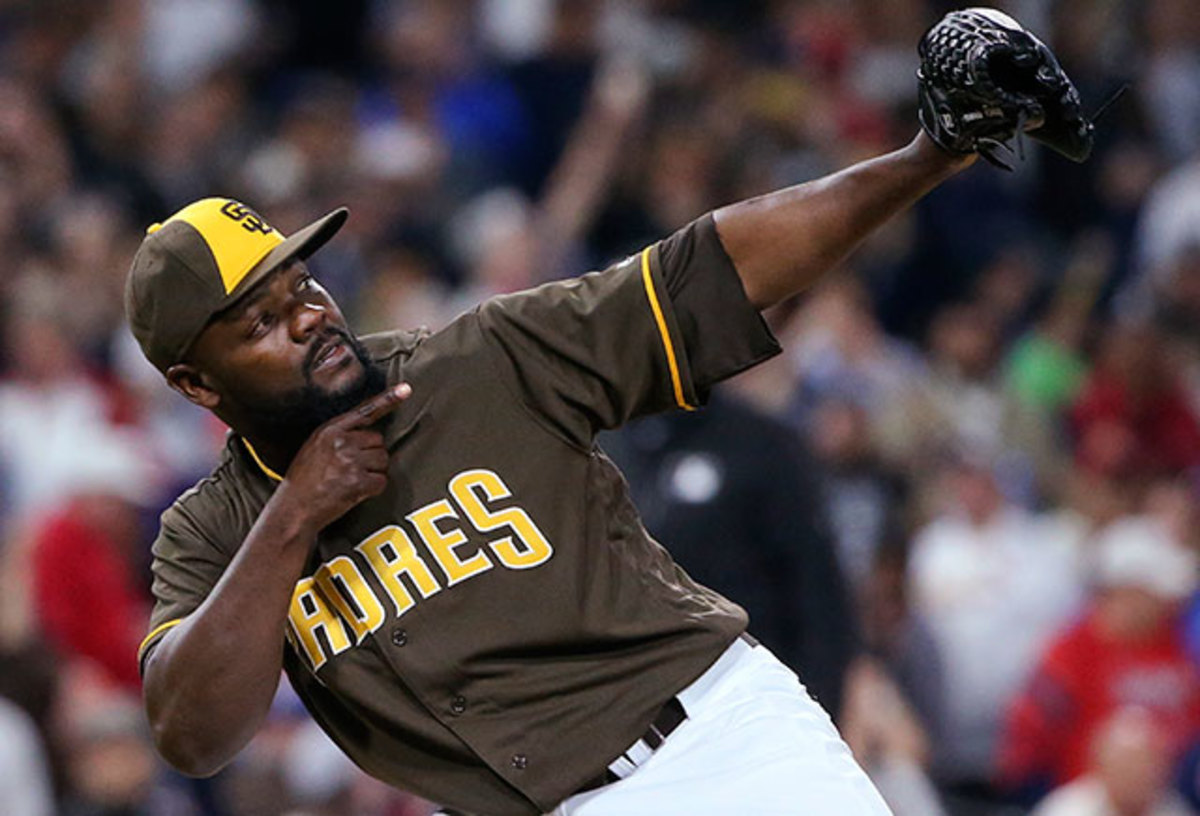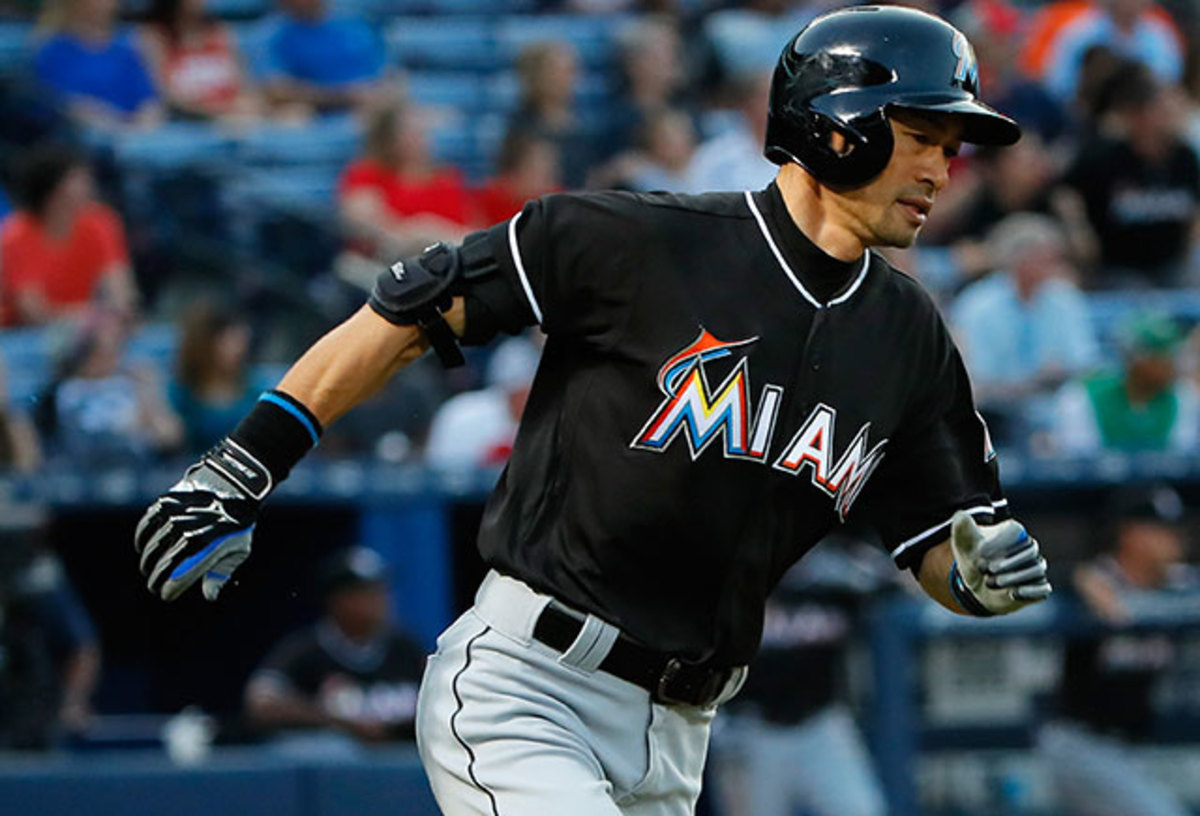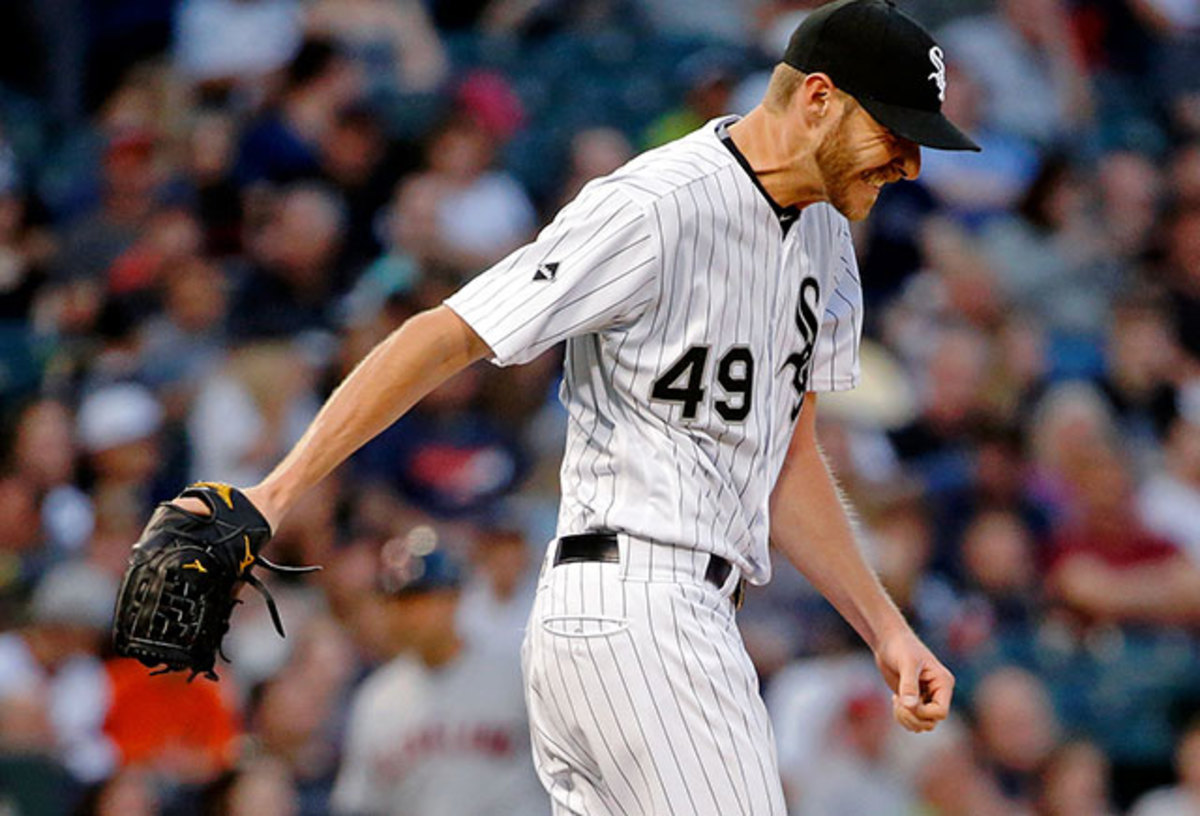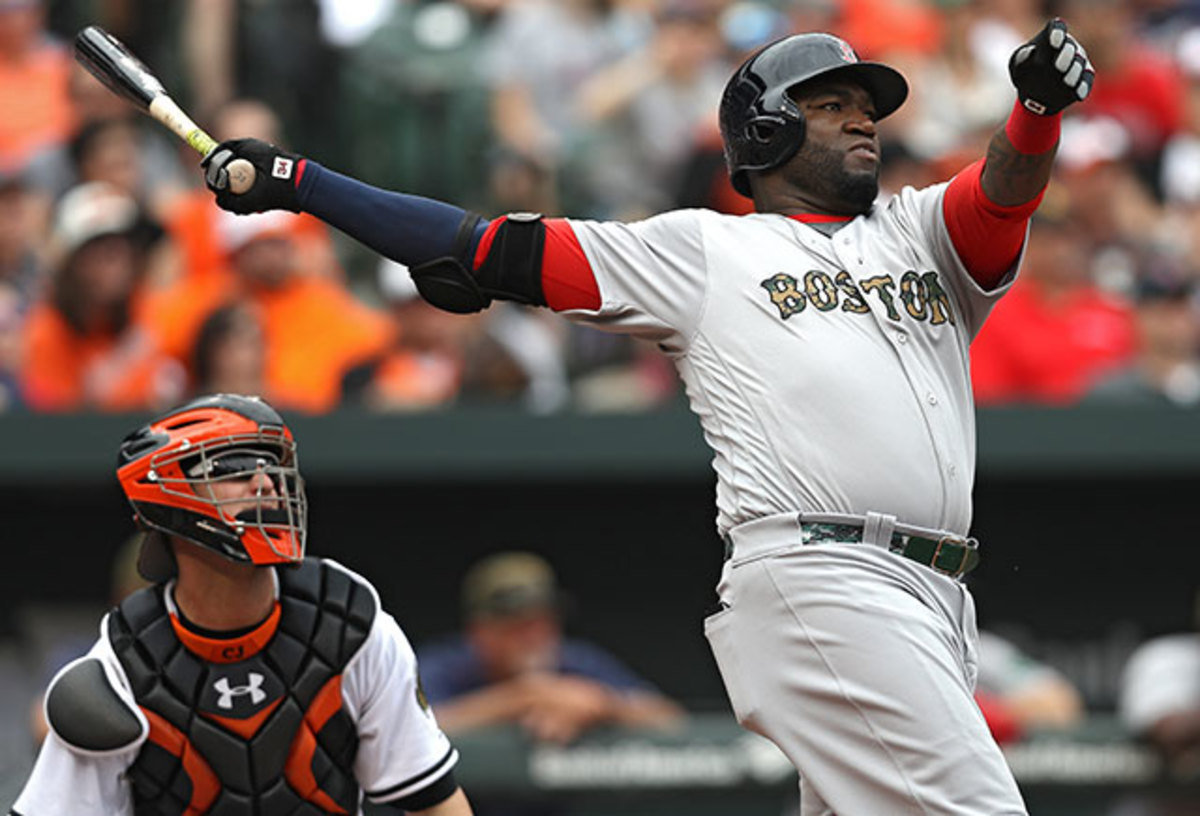The 30: Age is just a number in this week's MLB power rankings

Baseball is, for the most part, a young man’s game. The age curve has shifted, such that players now peak closer to their mid-20s than their late-20s. Younger still was last year’s rookie class, one that ushered in a dominant new batch of players and set an all-time record for best group of rookies by Wins Above Replacement.
Still, a few senior citizens are keeping hope alive for the older set. The Padres’ fun-loving closer is putting up Eckersley-esque numbers. The Marlins’ ageless hit machine has a shot at making history this year. Boston’s franchise player looks better than ever (and better than anyone else in the league) as he nears the end of his career. Meanwhile, the biggest contribution from an aging White Sox player might be from the guy who chose to walk away.
We are all getting older … and also wiser. It’s Week 8 of The 30.
Best Rebuttal Against the Argument That All Canadians Are Laid-Back Softies: Joey Votto
Joey Votto has always been a little different. He speaks fluently about everything from advanced stats to swing-plane minutiae. He’s a master at trolling opposing teams’ fans. He occasionally gets slightly irritatedat umpires. He might be better than anyone else in baseball at controlling the strike zone, and he ranks near the top of the league in being hilariously intense.
So when a paper airplane landed on the field during Tuesday’s Reds-Dodgers game at Dodger Stadium, Votto reacted in true Votto fashion: He sent that piece of errant loose-leaf straight to the great paper-airplane beyond.

Shoot Dem Arrows
One of the game’s worst relief pitchers last year, Fernando Rodney is suddenly unhittable.
30. Minnesota Twins (15–35 record, minus-75 run differential, last week: 30)
29. Atlanta Braves (15–35, minus-72, LW: 29)
28. Cincinnati Reds (17–34, minus-97, LW: 28)
27. San Diego Padres (20–32, minus-42, LW: 24)
26. Oakland A’s (23–29, minus-49, LW: 26)
25. Milwaukee Brewers (23–28, minus-35, LW: 27)
24. Arizona Diamondbacks (23–30, minus-29, LW: 22)
23. Los Angeles Angels (23–28, minus-17, LW: 23)
22. Houston Astros (23–29, minus-25, LW: 25)
Fernando Rodney is one of the most colorful pitchers that baseball has seen in decades. He’s a plantain connoisseur, a challenger of hat-wearing norms, an explorer of ballpark shrubbery and, of course, the greatest archer the game has ever known. When he’s pitching well, Rodney’s goofy demeanor endears him to his team’s fans.
For most of last season, he pitched incredibly poorly. As a Mariner, he allowed 81 base runners in 50 2/3 innings, posting a 5.68 ERA. Given a reprieve as a Cub, Rodney flourished under his old manager Joe Maddon, striking out 15 batters and allowing just one earned run in 12 regular-season innings. Still, entering this season at age 39 and with control issues even in some of his best seasons, Rodney looked like a lousy bet to last long as the Padres’ closer.
So much for that idea. Rodney has appeared in 19 games this season, throwing an even 19 innings and allowing zero earned runs. He can still be wild, as evidenced by the nine free passes he’s doled out. But he’s more than offset that potential problem by allowing just eight hits, none of those going for extra bases.
Sigh of relief: Matt Harvey returns to form for Mets against White Sox
Although 19 innings don’t constitute a big sample size, we can see how and why Rodney’s been successful. First, his velocity has remained remarkably consistent, even at an advanced age—he’s still firing his nasty sinker at 95 mph. He throws his sinker and changeup a combined 84% of the time, and they’re both still highly effective pitches: Opponents are hitting just .133 against the sinker and a microscopic .086 against the change. When Rodney gets two strikes on a hitter, everyone in the stadium knows it’s coming. Yet thanks to adjustments made years ago under Rays pitching coach Jim Hickey (the most underrated pitching coach in baseball), this is what happens when Rodney throws that pitch.
We know this isn’t going to last. Rodney won’t go through the whole season allowing a .182 batting average in play (105 points below his career norm), and some of those hits will start finding gaps and going over walls. More than that, you have to imagine general manager A.J. Preller will look to trade Rodney to a contender the first chance he can get, given that the Padres are going nowhere this year and are actively trying to restock their farm system.
But for now, the Friars have themselves a pitcher who’s both extremely predictable with his pitch selection and extremely ridiculous with his mound antics. Here’s hoping he sticks around to shoot arrows at invisible targets in the sky for years to come.

Still The One
At age 42, Ichiro Suzuki gives the Marlins a great contingency plan.
21. Colorado Rockies (23–27, minus-22, LW: 17)
20. Tampa Bay Rays (22–27, zero, LW: 21)
19. Detroit Tigers (24–26, minus-17, LW: 20)
18. Philadelphia Phillies (26–25, minus-44, LW: 16)
17. New York Yankees (24–26, minus-21, LW: 18)
16. Miami Marlins (26–25, minus-15, LW: 19)
15. Toronto Blue Jays (27–26, plus-5, LW: 13)
Coming into this season, seven of the 10 oldest players in baseball were pitchers. It’s easier to keep going when you’re a slop-throwing lefty relief specialist or an alien from whatever planet brings unlimited joy. But for position players, it’s a much tougher battle. Maintaining the kind of athleticism you need to keep putting up playable numbers is a tough task. To do so while also playing better-than-average defense is damn near impossible. In fact, only one of those 10 oldest players regularly takes the field, as opposed to DHing most of the time: the man, the myth, the legend … Ichiro.
Darvish’s strong return the final step in rebuilding of Rangers’ rotation
At age 42, Ichiro is the second-oldest player in the majors, behind only Bartolo Colon. To succeed, he relies on baseball skills that are very much the dominion of younger men: bat speed, agility and quick reflexes. By WAR, Ichiro’s on pace for his best showing since 2012—since ‘10 if we go on a per at-bat basis. His .317 batting average and .385 on-base percentage are his best since 2009. When it comes to controlling the strike zone, this is best version of Ichiro we’ve ever seen: No National League player with as many times at bat has struck out less often than he has, and no player in either league owns a better walk-to-strikeout rate. A bunch of underlying indicators suggest that this isn’t a fluke. Ichiro’s making more hard contact, hitting more line drives, swinging through pitches less often and swinging at pitches out of the zone less often than he has in many years.
Of course the biggest factor of all, as with Fernando Rodney’s sparkling start, is probably sample size. Ichiro is the Marlins’ fourth outfielder, which means Don Mattingly might be more inclined to give him playing time when the conditions are just right for an appearance. On the other hand, we’ve seen Ichiro paste opposing pitching when forced into action due to teammates’ injuries, like he did May 23 by banging out four hits against the Rays. Bottom line: When he plays, he hits.
The Marlins have been surprisingly competitive this year, and for them to stay within striking distance of the front-running Nationals and Mets, they’ll need lineup mainstays Giancarlo Stanton and Christian Yelich healthy and in the lineup. That, in turn, shunts Ichiro back to the bench. But the best teams offer a combination of front-line talent and superior depth, and while players like Cal Ripken, Jr. and Craig Biggio hurt their teams on the field in pursuit of records and milestones, the opposite holds true for Ichiro. Marlins fans aren’t merely rooting for their ageless wonder outfielder to get in the lineup so he can rack up the 39 hits he has left to reach 3,000 on this side of the Pacific. They want him in there because even after these years, Ichiro can still bring it.

Missing In Action
The swooning White Sox need to cash in on an unexpected windfall, as soon as possible.
14. Chicago White Sox (27–25, plus-20, LW: 6)
13. Cleveland Indians (26–23, plus-30, LW: 12)
12. Kansas City Royals (28–22, plus-2, LW: 14)
11. Los Angeles Dodgers (27–25, plus-31, LW: 15)
10. St. Louis Cardinals (27–25, plus-47, LW: 10)
9. Seattle Mariners (29–21, plus-53, LW: 5)
8. Texas Rangers (30–21, plus-21, LW: 7)
7. Pittsburgh Pirates (29–21, plus-36, LW: 11)
The controversy this spring surrounding Adam LaRoche’s teenage son and the tough decision faced by White Sox management ended with LaRoche abruptly announcing his retirement. The kerfuffle resulted in 10 zillion hot takes from 10 zillion overpaid talking heads, all offering their opinions as the definitively correct ones when it comes to clubhouse protocol, parenting and sports in general.
For the White Sox, the most important outcome of the whole episode figured to be something far more concrete. By hanging ‘em up, the 36-year-old LaRoche forfeited $13 million in 2016 salary. If the Sox could hang in the race this year, that suddenly available (and large) sum of money could trump any other contribution made by any other aging Pale Hose player.
If that money’s going to be spent, now would be a great time to do it. On May 9, the White Sox reached topped the Rangers, 8–4, in 12 innings, reaching a season-best record of 23–10. At that moment, they led the AL Central by a commanding six games. With the Cubs riding high in their own division, you could start to dream a little about an all-Chicago World Series. But while the North Siders have continued to excel since then, their South Side chums have not. The White Sox have gone a miserable 4–15 since then, and after getting shut out by the previously terrible Matt Harvey on Memorial Day, Sox fans could count seven losses in a row. They’re now as close to fourth place as they are to first. The Curse of John Danks is upon us.
The problem is figuring out what “now” can realistically mean. With the exception of a scant few big deals, trade deadline blockbusters tend not to be in play until late June, or even well into July. Teams can make an occasional, tiny, James Loney-for-cash-type trade this early, but that’s usually about it.
Dodgers’ Utley tortures Mets, records 5 RBIs as Syndergaard gets tossed
This is bad news, considering the multiple gaping holes on the roster. In the off-season, the White Sox aggressively tried to upgrade multiple positions: They acquired Dioner Navarro and Alex Avila to catch, Jimmy Rollins to play shortstop and Austin Jackson to man centerfield. All four rank among the worst in the league at their positions this year. Jose Abreu hitting well below career norms exacerbates that offensive shortfall. Meanwhile, Mat Latos has predictably turned back into a pumpkin after a strong first few starts, leaving the back of the rotation (Miguel Gonzalez is a replacement-level starter in his own right) in an ugly state. And while the bullpen does have some talent, White Sox fans seem to take to Twitter every few minutes to rip manager Robin Ventura for his handling of those relievers and for his in-game offensive strategies. The dilemma here isn’t only finding a seller this early in the season who’s willing to give up premium talent for something less than a million great prospects, but also figuring out which of these big holes to plug in the first place.
The AL Central remains without a dominant team and could very well be taken with fewer than 90 wins. The LaRoche bounty could still be leveraged into a quality acquisition a few weeks from now and maybe even parlayed into several roster upgrades. But Chris Sale and Jose Quintana can’t carry the club by themselves. If they don’t start getting ample help from their teammates soon, the promise of a blazing-hot first few weeks could turn to dust in a hurry.

Papi Power
David Ortiz might do something rarely seen in baseball: End a Hall of Fame career with his best performance yet.
6. Baltimore Orioles (28–21, plus-12, LW: 4)
5. New York Mets (29–21, plus-23, LW: 7)
4. San Francisco Giants (32–21, plus-19, LW: 9)
3. Washington Nationals (31–21, plus-52, LW: 3)
2. Boston Red Sox (31–20, plus-76, LW: 2)
1. Chicago Cubs (35–14, plus-133, LW: 1)
When it comes to great players in the final year of their careers, it’s often tough to watch. From Willie Mays toiling away as a Met to Harmon Killebrew’s swan song as a Royal, we’ve seen many superstars limp to the finish line.
Other times, we’ll see players go out, if not at the top of their games, then at least on a high note. Ted Williams’s last year was a monster, a .316/.451/.645 performance that ended with a long home run. Roberto Clemente put up strong numbers in his final season, though that probably comes with an asterisk, given his untimely death the following winter in a plane crash.
Still, one feat has eluded nearly every Hall of Fame-caliber player in major league history: ending his career with his best numbers ever. The best example I could think of was Sandy Koufax, who established new career bests in wins, ERA and ERA+ in his final campaign. Koufax retired after that magnificent 1966 season, but that was because the Left Arm of God got felled by excruciating pain, not because he was no longer the best pitcher in the world.
Awards Watch: Kershaw dominating NL Cy Young race; Sale leads in AL
David Ortiz has a chance to join that Koufax-ian company. Big Papi blasted his 14th homer of the season on Memorial Day, taking his season line to .337/.419/.727. By park-adjusted offensive metrics, that makes Ortiz the best offensive player in the majors this year—by far. That’s a miraculous feat for someone who’s 40 years old. If Ortiz’s numbers hold up over the entire season, he would also set career highs in batting average, on-base percentage and slugging. In short, it would be the single best campaign for a future Hall of Famer, and it’s coming in his 20th season.
There’s not much here that would suggest it’s a fluke, either. Ortiz’s .341 batting average on balls in play is well above career norms, but he’s also hitting balls hard more frequently than ever before. He’s on pace for an incredible 44 homers, but his home run-per-flyball rate is just about in line with his career number. He’s making more contact on pitches in the zone than ever before, with a swing-and-miss rate that ranks among the best of his career.
Plenty of obstacles remain, of course. Ortiz hasn’t topped 146 games played in a season since 2009, and the Red Sox would do well to manage his playing time this year too, especially with a loaded offense that’s also getting big numbers from Jackie Bradley Jr., Xander Bogaerts, Travis Shaw and Dustin Pedroia. Papi could also fall into a slump at some point, which you have to figure has to happen sooner or later, especially for a 40-year-old.
Still, even if Ortiz is merely good for the rest of this year, this could go down as one of the greatest swan songs in baseball history. Considering the strength of his supporting cast, getting one more ring is very much in play too.
